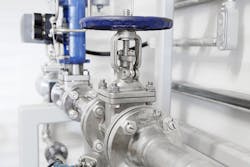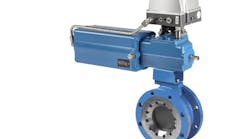A growing demand for integrated systems includes rotating equipment, such as a pump; a compressor or gas turbine; and all of the auxiliaries, such as valves, instrumentation and piping, in one or a few skids.
Machinery and rotating equipment packages require sophisticated instruments, valves and control systems, and special consideration should be given when selecting these component solutions. For example, many instruments and valves can be susceptible to damage, abnormal wear or malfunction if they are mounted in a location where they are subject to vibration or pulsation from the larger system. If any part of the flow instrumentation, control valves or actuation equipment might be subject to vibration or pulsation in a machinery package, the affected instruments should receive special attention with vibration-free supports or other provisions.
This article discusses how to select control valves and flow meters (and their pipe run requirements).
Globe valves
A globe valve design is intended to control flow, and it can also be used as an isolation valve. Its design minimizes seat wear during valve opening and closing as the disc moves toward and away from the body seat, providing a uniform clearance and flow around the disc edge. Globe valves are suitable for throttling, ideally when the disc is at least 20 percent open. Otherwise flow-induced vibration can damage the valve. For this reason, ensure the valve is not too large for the intended flow condition.
For larger size and higher-pressure class valves, consider a provision to guide the disc throughout its travel for better operation and reliability. A guided disc ensures that the disc will not deflect or cock during travel, resulting in uneven seat wear and leakage. The disc can be guided in a cage, at a single location near the stem, on one or more outside diameters on the disc, or by machined body-guide ribs.
When conditions require a valve to be less than 20 percent open, consider using a non-rotating disc rather than the standard swivel disc. That would reduce harmful disc and stem vibration, but may result in accelerated seat wear and leakage.
Butterfly valves
Butterfly valves are available in several configurations. Double-flanged and wafer (lug) types provide more or less tight shutoff in the closed position, while others are suitable for flow regulation. Wafer-type butterfly valves, particularly for large sizes at or above 6 inches, offer the most compact design for integrated rotating equipment systems.
They can be used in very compact skid designs and are also available different materials, such as gray iron, ductile iron, bronze, steel, nickel-base alloy and special alloys. Although butterfly valves can operate in any orientation, the stem horizontal is preferred to avoid debris collection and bearing wear that can occur in a vertical orientation.
Differential pressure flow meters
Flow can be measured in many ways for integrated rotating equipment systems. One option, differential pressure, is the most common.
Additionally, a sharp- (square-) edged concentric orifice plate is used frequently because of its low cost, adaptability and availability of established coefficients. For most services, orifice plates are made of corrosion-resistant materials, often type 304 or 316 stainless steel. In particular, eccentric orifices or segmental plates should be used for dirty fluids or wet gases, while quadrant orifices should be used for viscous liquids.
Orifice plates offer strong repeatability, ease of installation, use of one transmitter regardless of pipe size, low cost, different types and materials, and relative ease to be changed. They do have limitations. They are susceptible to damage from foreign materials entrained in the fluid and to erosion, and they require straight runs of upstream and downstream piping.
Venturi and flow tubes are used with differential pressure flow meters where high capacity and minimum head loss are critical. They offer strong repeatability and low permanent loss, yet their cost is relatively high and the size and weight of the installation can require additional support. Like the orifice plates, they require straight runs of upstream and downstream piping.
Diaphragm differential pressure transmitters are used extensively in different units and packages. The transmission signal can be either pneumatic or electronic but, in most cases, is electronic. Because of their low displacement, these instruments can generally be used without a seal or condensate pot. In line mounting is best if the location is accessible and has minimum vibration. Gas meters are mounted above the line to allow any condensate to drain back, while liquid meters are mounted below the line to prevent gas or vapor from being trapped in the sensing lines, which could cause errors from unequal static heads.
Bellows
In a bellows meter, the bellows is opposed by a calibrated spring system and is filled to prevent rupturing when the bellows is over-pressured and to provide pulsation damping. They can be line-mounted or remotely mounted at grade or on platforms with adequate support.
Variable-area
Also known as rotameters, these flow meters include a wide flow range up to 10-to-1, linear transmitter output and minimal effect of gas compressibility. Limitations of variable-area meters include a lack of availability in all materials, viscosity ceiling limits that are provided by manufacturers and the need for vertical installation.
Turbine
Turbine meters are used where high accuracy, around 0.5 percent and rangeability of 0.2 percent or better, is required. Their outputs are suitable for control or recording applications, and they are also ideally suited for batch control applications. Compensation for nonlinearities because of viscosity is also available. They can have a high or low flow rate for a given line size.
Limitations of turbine flow meters include their susceptibility to wear or damage if the process stream is dirty or non-lubricating. They are also susceptible to damage from over-speed and pulsing flow. They require maintenance and may need to be returned to the manufacturer for recalibration after a bearing change or other maintenance. Their rangeability is affected by high viscosity and low density. They can be higher in price than other meters, and they require strainers.
Positive displacement
Positive displacement meters are used for their strong repeatability across wide flow ranges for heavy or viscous fluids. They support accuracies as high as 0.2 percent of actual flow. Ensuring high accuracy requires some form of meter proving. Typical repeatabilities are 0.1 percent, and a rangeability of 10-to-1 can be achieved.
Among their disadvantages are susceptibility to mechanical wear and not being interchangeable. They should be supplied to match the service, require filter or strainer, and have special considerations for installation.
Vortex
Vortex meters are used in applications that require wide rangeability and accuracy. They have an accuracy of 1 percent of rate and are available in many sizes. Their construction material options are limited, and they are generally unsuitable for slurries or high-viscosity liquids.
Coriolis mass
Although Coriolis meters are nonintrusive, in some designs the flow path through the meter is circuitous. In addition, the flow is generally separated into two tubes that are much smaller in cross-sectional area than the inlet process piping. For this reason, it is relatively easy for any secondary phase to build up in a Coriolis flow meter that has not been carefully installed. The pressure loss can be substantially higher than other types of nonintrusive elements, and cavitation and flashing can occur with volatile fluids.
Improper installation may result in startup problems, so follow the manufacturer’s recommendations strictly. Pressure containment enclosures are available when required.
Coriolis flow meters are not affected by distortion of the velocity profile and do not usually require metering runs. Although they generally cost more than other types, they measure mass flow rate without the need for additional elements. The ideal application of these flow meters is in difficult fluids or applications in which their accuracy justifies the higher cost.
Pulsation in machinery packages
The measurement of pulsating flow, such as flows in reciprocating compressors or pumps, is difficult and should be avoided if possible. Head-type flow meters and instruments with mechanical movements, such as positive displacement meters and turbines, should not be used in pulsating-flow applications. Too often, the flow measurement is not dependable, and the pulsing may contribute to premature wearing of mechanical components.
Amin Almasi
Amin Almasi is a senior rotating machine consultant in Australia. He is a chartered professional engineer of Engineers Australia, IMechE, holds bachelor’s and master’s degrees in mechanical engineering, and is a registered professional engineer in Queensland. He specializes in rotating machines, including centrifugal, screw and reciprocating compressors; gas turbines; steam turbines; engines; pumps; subsea, offshore rotating machines; LNG units; condition monitoring; and reliability. He can be reached at [email protected].



